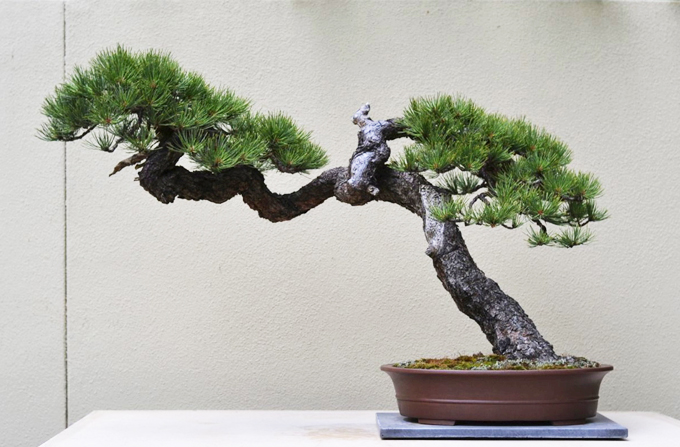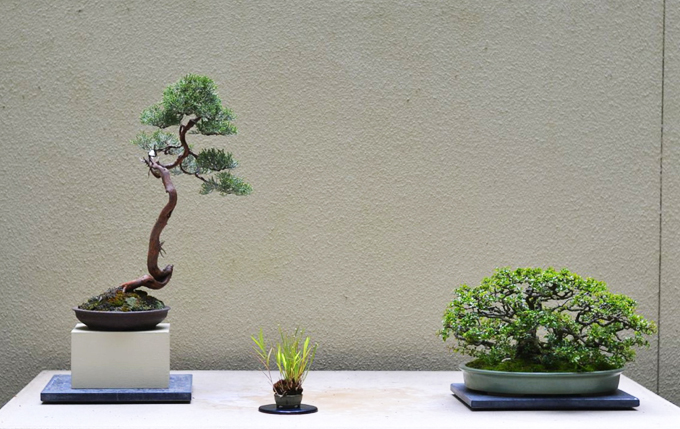 I was struck by this large Ponderosa pine at the 3rd U.S. National Exhibition. It’s even bigger than it looks here and also has more depth and movement than this two dimensional representation shows. Still, you can get some idea of its natural power. It belongs to Ryan Neil.
I was struck by this large Ponderosa pine at the 3rd U.S. National Exhibition. It’s even bigger than it looks here and also has more depth and movement than this two dimensional representation shows. Still, you can get some idea of its natural power. It belongs to Ryan Neil.
New American Masters show at the Pacific Rim Collection
Michael Hagedorn and Ryan Neil both apprenticed in Japan where the term Master isn’t thrown around casually, and my guess is that neither of them is completely comfortable with it being used in reference to themselves. However, whatever term your choose, there’s no question that Ryan and Michael are both highly skilled bonsai artists whose efforts are helping push North American bonsai closer to world-class bonsai.
Don’t miss it!
If you are anywhere near Seattle in the next couple weeks (until July 15th), don’t miss the show at the Pacific Rim Bonsai Collection. It’s David DeGroot’s brainchild (David is the curator of the Pacific Rim Collection) and it features the bonsai of both Ryan and Michael. For more on the show, including one of Michael’s now famous humorous anecdotes (Michael is the author of the eminently readable and often quite funny Post-Dated: the Schooling of an Irreverent Bonsai Monk), you can visit Crataegus Bonsai.
Artisans Cup
It would be remiss to talk about Michael and Ryan without mentioning their upcoming (2013) Artisans Cup. But rather than suffering through more of my ramblings, this might be just the spot to quote Colin Lewis: “What’s really significant with the Artisans Cup is the venue: The Portland Museum of Art. This is the first time a major art establishment has truly acknowledged bonsai as worthy of its attention. It’s a huge step forward and will hopefully set a precedent for future events in museums across the country.” From the comments on our recent post about the Artisans Cup.
 Western juniper, grass, ‘Chojubai’ quince—Michael Hagedorn
Western juniper, grass, ‘Chojubai’ quince—Michael Hagedorn


Michael and Ryan do great styling work with conifers, especially pines and junipers. I can not give enough praise about their bonsai. I’ve noticed on your blog that many trees of western artists falls in the category of large, twisted, and lots of deadwood, trunk styles. I hope this is not becoming the trademark of western bonsai. We should not forget that there are many more varieties of trees than pines and junipers, and many more styles than huge, tortuous trunks.
Hi Kenneth.
Thanks for you insightful comments and agreed there is much more to bonsai than the large, twisted trunks with lots of deadwood.
I think the dominance of the large rugged style has a lot to do with our native material from the Rockies, Sierras, Cascades and so forth. There’s so much to choose from in those places and most of the most desirable ones are those massive old conifers.
Even here in the East where the pickings are much slimmer, we have our native larches, which often look their best with some twists and some deadwood. The same goes for Florida with their native Buttonwoods.
This and maybe our American penchant for ‘bigger is better.’
However, if you look at the U.S. National Bonsai Exhibition albums (1 and 2 are out and 3 is coming) you’ll see plenty of trees that don’t fall into the above mentioned category. You can expect more in the future as our tastes develop. Still, given who we are what’s available, I suspect the big gnarly types will remain our crown jewels for a while.
Couldn’t have happened to two nicer guys! I hope to get up there.
I agree about the north american bonsai talk here. I like dead wood too. Happily, I’m launching my new Bonsai Art Studio here in downeast Maine with an emphesis on fine bonsai design. Good Technical skills to develop bonsai. Now that i have returned home to Maine, conifers are the way to go, for most of my work. As some deciduous trees leaves do not reduce well. Like maples. I strive to carry on here after 25 years of continuous learning from my teachers and new experts of the art. A few, Colin Lewis, Ted Matson, Bijorn B., and meeting Ryan in Cinicinnati last year.
The mid west was my home for six years. My hope is that Maine will become known for its bonsai in the future.
I will do my best to provide education and bonsai culture in the northeast.
Maybe i can get You all tp come to Maine.
Hi Aaron,
Good luck!
I know this post has been out for a long time, but here’s my two cents: The gnarly deadwood style is something you’ll find much more of at Ryan’s than at Michael’s. I think Ryan is more the Kimura to Michael’s Kyuzo Murata. Maybe I’m imagining it, but I think part of the Japanese legacy is that that bonsai experts are expected to have a measure of over-the-top junipers to be taken seriously. They command much more attention than accent plants, bunjin, and inherited deciduous.
I think (and deeply hope) that various North American regional bonsai styles will evolve and develop as more native species are used. Here in the Pacific Northwest, I predict that in a few decades everyone will be growing native Vine maples, Englemann spruce, Subalpine fir, and Coast redwoods. I would also like to see more people using our own stunning native deciduous azalea, as well as alders, chokecherries, huckleberries, manzanita, and even willows. A few of us here in Portland are experimenting with nearly everything native around here.